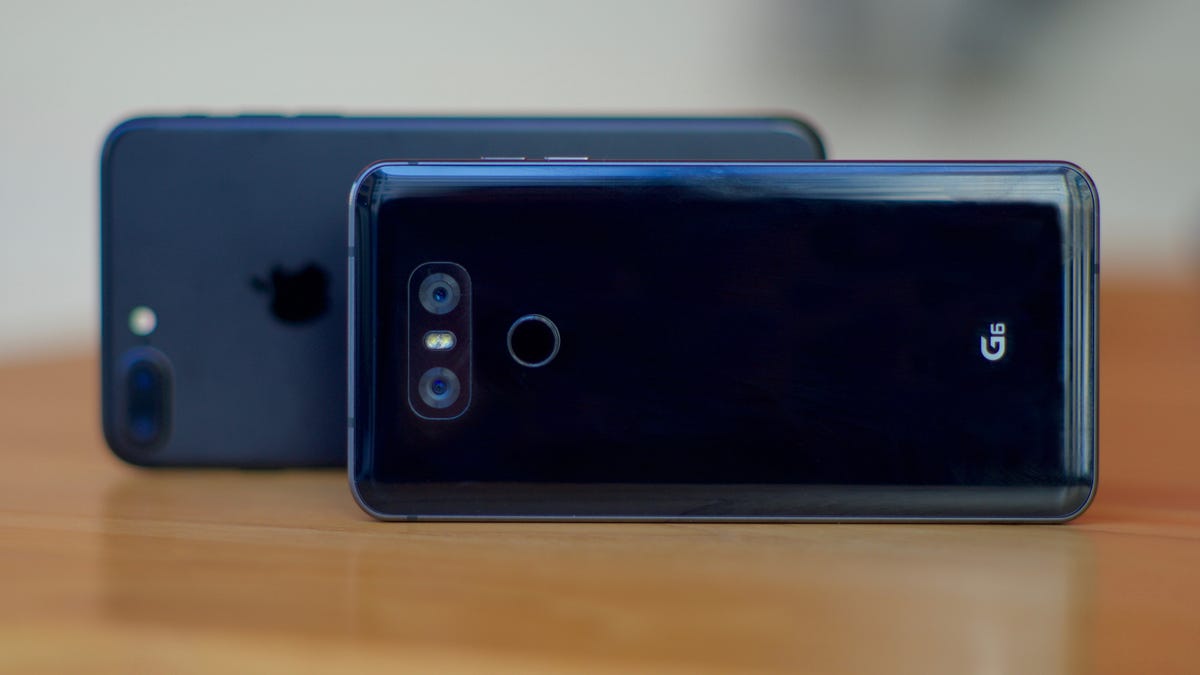Are phone cameras going the way of shaving razors?
Commentary: Dual-cameras on smartphones are officially a thing. But will phone makers stop at just two?

The LG G6 and iPhone 7 Plus both use dual-cameras but in slightly different ways.
Dual-cameras are quickly becoming a regular feature on smartphones. Last fall, Apple released the iPhone 7 Plus which notably had not one but two rear cameras. Other phone makers like LG, Huawei, Asus and ZTE also have phones with dual-cameras, and this makes me wonder: Will phone makers stop at two?
Just the 2 of us
I rolled my eyes when I first heard about a phone with dual-cameras. It seemed like a gimmick in the same way multi-blade safety razors are: First there was a dual-blade cartridge, then a triple-blade one and then a quad. The company Dorco has a razor called the Pace 6 Plus which has... yes, six blades.
However, dual-cameras on a smartphone actually solve a space problem: better pictures come from larger cameras, yet as phones get thinner there is less room for bigger optics. Combining two small cameras with some clever processing allows for better image quality without the need for a larger lens and sensor. It's kind of the "have your cake and it eat too" philosophy applied to smartphone photography.
Not all dual-cameras are the same
Phone makers utilize dual-cameras in different ways. Initially, they were aimed at capturing 3D video -- remember when that was a thing? But then the HTC One M8 came out with dual-cameras and allowed people to refocus a picture after they took it.
The iPhone 7 Plus uses two cameras to zoom in closer on a subject without losing image quality.
The iPhone 7 Plus uses two rear cameras to allow optical zoom without loss of image quality. The 7 Plus can also digitally create bokeh (background blur) with a feature called Portrait mode.
The LG G6 also uses two cameras to optically zoom, but does so between a standard angle and a wide angle view -- the 7 Plus zooms between a standard angle and a tele lens.
Huawei uses dual-cameras in a variety of ways depending on the phone. On its Honor 6X -- a budget phone nonetheless -- you change focus after you take a photo and there's a background blur mode similar to the iPhone 7 Plus' Portrait mode.
On Huawei's P10, there's a black-and-white camera which captures detail and lighting and a color camera that gathers color information. The P10 combines the two much like a coloring book resulting in pictures with overall better image and color quality.
And what about Samsung and Google ? Currently neither company has a phone with dual-cameras. But, there are rumors that the upcoming Galaxy Note 8 will have dual-cameras. This is curious to me because Samsung had an amazing line of now-discontinued mirrorless cameras like the NX1 which was a CNET Editors' Choice. Bringing some of the NX1 's image mojo to a dual-camera phone would be incredibly exciting.
Is 3 a crowd or an innovation?
But why stop at just two? Could there be a Galaxy S9 with triple rear cameras? Or an iPhone 11 with a quad camera system? If two cameras offer improved image quality and nifty features like focusing after the fact, what could a quad camera system offer?
For example, the iPhone 7 Plus has two cameras: one with a 28 mm lens and the other with a 56 mm lens. But if it had four cameras, there could be a 24 mm lens, a 28 mm lens, a 56 mm lens and a 70 mm lens. The result would be a phone with the coverage of an 24-70 mm zoom lens, one of the most common and versatile lenses sold. You would be able to zoom in (even more than the iPhone 7 Plus) for close portrait shots of friends and family or zoom out (as wide as the LG G6 ) to have a wide angle lens for tight spaces. All this without loss of image quality.
A side effect of multiple cameras could be a wider implementation of augmented reality (AR) on phones, too. The Lenovo Phab 2 Pro uses three rear cameras (one is an infrared camera) to run Google's Tango software.
Let there be light
The idea that phone makers might add more rear cameras to phones isn't that far-fetched. The company Light is releasing a phone-sized device called the L16 which has 16 13-megapixel cameras. The L16 isn't a phone even though it runs Android. The 16 cameras are made up of five 28 mm lenses, five 70 mm lenses, and six 150 mm lenses.
The smartphone-sized Light L16 camera is actually made up of 16 different cameras capable of 52-megapixel photos.
For any given image, it takes a picture simultaneously with 10 of those cameras. The images from the 10 cameras are tiled and layered together with software to create a single high resolution, high detail, low noise picture -- up to 52-megapixels.
While I don't think there will be a phone with 16 cameras anytime soon, the L16 shows that using multiple small cameras to create high-quality images is possible.
Goodbye prosumer dSLRs
Dual-cameras on phones are definitely here to stay. And over time, two cameras will turn to three then four then five and so on. Of course, all this will depend on faster chips to power all of that image processing as well as software to make the experience nearly instantaneous for users. Photos would be on the level with those taken with entry-level and prosumer dSLRs. And just like the smartphone led to the demise of the point-and-shoot camera, a phone with multiple cameras might spell the end for prosumer dSLRs.

